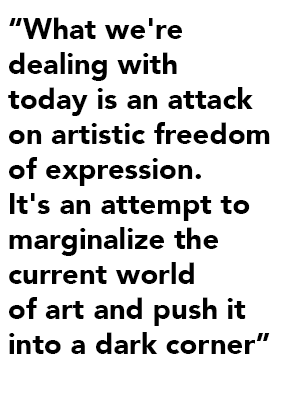
"Making Use: Life in Postartistic Times" exhibition view. Photo by Bartosz Stawiarski
Yet at the end of last year a string of firings of heads of various overseas Polish Cultural Institutes sparked concerns that Poland’s conservative government was starting to make their presence felt on the country’s cultural output. Dorota Monkiewicz, director of the National Museum in Wroclaw was dismissed, coinciding with the city’s nomination as the European Capital of Culture, whilst Katarzyna Wielga-Skolimowska was dismissed as head of the Polish Cultural Institute  in Berlin in December for allegedly focusing programming too heavily on “Jewish issues.” The Polish ambassador to Germany, Andrzej Przylebski is said to have written a note advising that a Polish-Jewish dialogue should not be exaggerated. Przylebski claims his request is blameless, that he was insinuating the necessity for a larger cultural dialogue. However such a disruption has been interpreted by some as an indication of a move towards a cultural policy founded on a notion of historical legacy and anti-Semitic whitewashing; in other words, a rewriting of history rooted in nationalism.
in Berlin in December for allegedly focusing programming too heavily on “Jewish issues.” The Polish ambassador to Germany, Andrzej Przylebski is said to have written a note advising that a Polish-Jewish dialogue should not be exaggerated. Przylebski claims his request is blameless, that he was insinuating the necessity for a larger cultural dialogue. However such a disruption has been interpreted by some as an indication of a move towards a cultural policy founded on a notion of historical legacy and anti-Semitic whitewashing; in other words, a rewriting of history rooted in nationalism.
“The current situation feels very much like a step back into what we'd managed to escape many years ago,” says Marta Kolakowska, founder of Leto Gallery in Warsaw, a forerunner in the Polish contemporary art scene. “What we're dealing with today is an attack on artistic freedom of expression. It's an attempt to marginalize the current world of art and push it into a dark corner,” she says. By withdrawing financial support for art projects, public institutions and publications and implanting new institutional directors elected by government bodies, the state is slowly but surely ensuring that their version of events is heard. “There's no room for debate,” says Kolakowska, “everything happens in the corridors of the ministry without broader consultations, conversations. There is even evident meddling in the media.”
For those such as Kolakowska who have been instrumental in the process of developing a local art market and discourse following the fall of communism, these new oppressive structures are reminiscent of the effects of martial law on the arts in 1980s Poland. However this period remained rich in terms of artistic production. Art slipped into the underground, and took on new languages: the blunt, ironic language of expressionism, which provided an incisive commentary on the political situation of the time, as well as the contrasting language of magical realism, taking a stark departure from actual reality.
Similarly, there still remain sites for resistance. London/Poland-based artist Joanna Rajkowska describes the PiS “a bit like strimmer out of control, cutting down plants that stick out too much but missing others.”
“They think firing the heads of the Polish Cultural Institutes, firing ambassadors and cultural attachés makes them look like they have a plan.” As such, this haphazard methodology has allowed many artists to continue to express their views in the form of political projects.
In their article So Far, So Good: Contemporary Fascism, Weak Resistance, and Postartistic Practices in Today’s Poland Independent curator Kuba Szreder and feminist Philosopher Ewa Majewska highlight the emergence of a postartistic weak resistance in the face of such mounting fascisms. The term postartistic refers to Polish theoretician of conceptual art Jerzy Ludwinski’s coinage, referring to a “realm of expanded artistic practices.” They cite artist Natalia Romik, an artist whose Nomadic Shtetl Archive saw her visit ten formerly Jewish towns, “to weave a spectral Jewish presence back into the social fabric, without imposing a ready-made version of this past/presence—thereby avoiding archivistic violence.”

Joanna Rajkowska, Zechstein Sea, 2015, The Baltic Sea Culture Centre - St. John Centre Curator: Ola Grzonkowska
This notion of Postartistic practice was the focus of the 2016 exhibition “Making Use: Life in Postartistic Times,” at the Museum of Modern Art in Warsaw reflecting on the possibility of artistic practices to impact on reality. The exhibition also incorporated contributions from activists from all fields, as well as theorists and free universities.
Rajkowska herself identifies as one of Poland’s many artists “against a new weird regime,” someone who “protests within and with their quiet work.” Under the PiS, culture, “with its extremely complex views of the world (and our place in it), constantly questioning and undermining the obvious, the assumed, and especially the taboo,” is under special surveillance. However, at least for the moment, voices of dissent are still able to emerge, “I wonder sometimes whether they really know who, in fact, really counts and who runs the artistic scene in Poland,” says Rakowska wryly.









